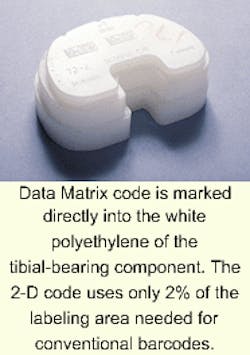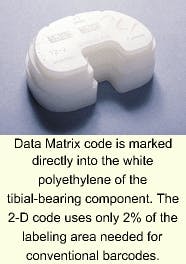Two-dimensional codes come into focus
James Hahn
Recent improvements in imaging and illumination technology now make it economically feasible to add the space-saving two-dimensional (2-D) Data Matrix code to the current range of barcodes used in manufacturing or packaging processes. Competitive world markets are driving manufacturing companies to a high level of automation requiring in-process identification for greater processing efficiency and quality levels. In-process quality tracking reduces manufacturing costs and provides for postproduction product tracing. The small Data Matrix code means flexibility in placement and capability to mark items too small for barcodes.
Because of the code's small size and geometric structure, it can easily be directly marked on an object's surface by inkjet, laser etch, or dot peen (pin stamp). These direct marks are typically much lower in contrast than their printed label counterparts. Historically, low symbol contrast meant vision systems were required to achieve acceptable read rates. However, with the improvements in imaging and illumination technology, along with the advent of the self-contained 2-D scanner, equipment prices have dropped to less than one-third the cost of vision systems. This is also significant in packaging-validation applications using optical character recognition or optical character verification. Using Data Matrix for validation provides considerable economic advantages.
Data Matrix code is now being adopted both in manufacturing and in laboratory research and development. For directly marked applications, the cost of using 2-D symbols is further reduced by the elimination of labels, which can be a significant cost in high-volume operations or where special labels are required. Like the retail checkout applications that drove 1-D barcode adoption in the late 1970s, industrial applications are driving 2-D code adoption now. Matrix code marking is being used for process error-proofing, work-in-progress tracking, and for postproduction tracing.
Greater capacity in less space
Data Matrix code users can track up to 100 times the amount of data or track the same data using only 2% of the labeling area of a barcode and gain greater accuracy. The Data Matrix code is a far more compact and versatile option for automatic-data-capture applications than either the standard barcode or 2-D stacked barcodes.
Several industries have adopted 2-D standards. Both the Electronic Industries Association and the Automotive Industry Action Group support Data Matrix code. In the automotive industry, component vendors are using 2-D to track keyless entry systems, radio components, and air-bag system subassembly units. An automotive electronics company is directly marking Data Matrix code to track work in process and to allow its customers to monitor the quality of its goods.
The new 300-mm silicon-wafer process being adopted by the semiconductor industry uses Data Matrix code exclusively. Data Matrix identification helps identify problems on the production floor and also helps to isolate parts for recall, a multimillion dollar problem within many industries.
Scanning technology
Reading the Data Matrix code is accomplished through the use of digital CCD (charge-coupled device) scanners. Two-dimensional scanners are unique in their ability to read data accurately and quickly in low-contrast conditions and from directly etched markings on metal and other surfaces.
Scanners introduced to the market within the last year bridge the gap between current barcode systems and new 2-D applications. They read both traditional barcodes and matrix codes. The ability to autodiscriminate between all codes is important during the phasing in of newer high-density codes, for instance, as a manufacturer adopts 2-D codes to meet immediate information or space requirements for some identification applications while retaining barcode identification for others.
A 2-D application
Howmedica Osteonics, a division of Stryker (Rutherford, NJ), laser marks Data Matrix code for error-proof identification of artificial joints by size and orientation. Previously, the company had to rely on costly three-dimensional vision technology to make sure the correct part was matched to its paperwork and packaging. Says Meg Smith, manufacturing cell manager, "We needed a solution that did not add to manufacturing costs or labor requirements. By using the mark in manufacturing, we eliminated redundant manual data entry. By using the mark in the packaging process, we cut some of the labor-intensive work there as well. We're doing something that no one else has done before."
Marking parameters were established for each type of surface to be etched to ensure symbol quality. With settings established, the company can mark a variety of surfaces with turnkey changes requiring scant downtime (see photo). "We can identify the part based on what it is, not based on what any piece of paper says it is," says Smith. By marking the parts, Osteonics has reduced the cost of positive identification and has streamlined its manufacturing operation.
Future of 2-D code
Two-dimensional codes are now being implemented and relied on as an integral part of manufacturing processes. The integration of new technologies into established processes does not happen overnight. Many companies have been working on this integration for several years and are relying on the benefits of 2-D code to solve critical identification requirements strategic to their future business opportunities.
JAMES HAHN is president and CEO of Auto Image ID Inc., Cherry Hill, NJ 08003; e-mail: [email protected].

